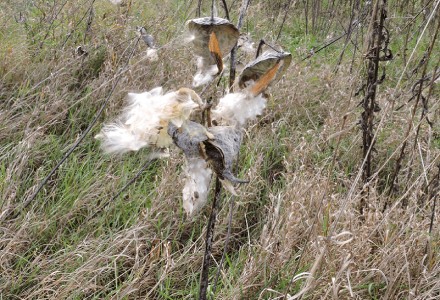
Milkweed Facts
- Perhaps most notably, the word Milkweed serves as the collective common name for an entire genus of flowering plants. Furthermore, this highly impressive genus contains roughly 200 recognized plants. Its common name derives from the presence of naturally occurring latex and alkaloids in its white colored sap.
- In addition, the fascinating members of this remarkable group also serve a very vital ecological function, as well. That’s because these plants serve as one of the few sources of food for the larvae of several types of butterfly. Most likely the best known of these Lepidoptera is the gorgeous Monarch Butterfly.
- In fact, this unique plant has numerous other uses, as well. In point of fact, dried Milkweed often gets used as a filling for hypoallergenic pillows. Due to its rather extreme absorption capabilities, the fibers of this species also have another surprising role. That’s due to the fact that these often serve to clean up oil spills.
- Since the term Milkweed applies to so many plants, conservation statuses naturally vary. Thankfully, for the moment, only a few appear on the IUCN Red List. Nonetheless, all of them must be considered to be at least in potential danger. The ongoing effects of climate change likely threatens them, as it does many other species.
Related Articles
Snowdrop Menzie’s Wallflower Pine Lily
Milkweed Physical Description
Since the term Milkweed represents the generic name for more than 200 different species, physical differences naturally occur. Nevertheless, many physical similarities understandably exist between the various plants contained within the remarkable genus. It’s for this very reason that the many separate species share the same genus, after all. One of these similarities remains the fact that all of them are herbaceous perennials.
Furthermore, all known forms of the quite remarkable Milkweed produce some of the most complex flowers in the world of plants. These gorgeous blooms even compare with orchids in complexity, if not beauty. Its marvelous blossoms open up to reveal an incredibly fluffy interior. This distinctive texture actually aids the plant in pollination. Understandably, however, sizes and colors frequently vary widely between the various flora.
- Kingdom: Plantae
- Phylum: Angiosperms
- Class: Eudicots
- Order: Gentianales
- Family: Apocynaceae
- Genus: Asclepias
Milkweed Distribution, Habitat, and Ecology
The different plants qualifying as Milkweed actually appear on three separate continents of the world. These diverse and widely separated locations consist of North America, South America, and Africa. More precisely, however, the greatest percentage of varieties inhabit the countries of Mexico and the United States.
Although these amazing plants can be adaptable if the situation requires it, most specimens have decidedly specific habitat preferences. More specifically, the vast majority of species and individuals appear in areas of damp soil. Most often this consists of such locations as the edges of ponds, streams, lakes, and even ditches.
Every form of Milkweed also utilizes a unique method of pollination. Amazingly, this quite often actually proves fatal to non-native bee species. The pollen of the flora groups into pollinia and is then held within five slits in the flower. Native bee varieties grow large and strong enough to escape from these slits. Smaller, non-native species often become trapped within the Milkweed and perish.
But, its amazing qualities do not end there. That’s because each variety also forms an important source of nectar for some endemic species of invertebrates. These mainly consist of numerous species of bees, wasps, and a variety of other insects that feed on nectar. However, a few varieties seem to be quite toxic.
Species Sharing Its Range
Opossum Hooker’s Lips African Penguin
Check out our other articles on Magnificent Mammals of Australia, Bee Hummingbird, Loktak Lake, Pea Crab, Goliath Stick Insect, Tiger Rattlesnake, Indian Giant Squirrel

